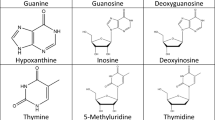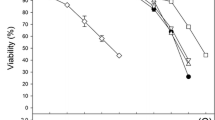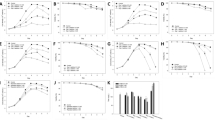Abstract
In this work, water-soluble extracts of Ganoderma lucidum spores (Gls), a Chinese medicinal herb that possesses cell growth stimulating function, were found to be an effective growth factor for Chinese hamster ovary (CHO) cell cultivation. The Gls extract was prepared and supplemented to CHO K1 cell culture media with various serum levels. Our results obtained from both the static culture and the spinner-flask suspension culture showed that use of small-amount Gls extract effectively promoted cell growth and suppressed cell apoptosis induced by serum deprivation with normal cell cycle maintained in a low-serum medium. The low-serum medium containing 1 % (v/v) fetal bovine serum (FBS) and 0.01 % (w/v) Gls extract showed a comparable performance on both cell growth and fusion protein productivity with the conventional CHO culture medium containing 10 % (v/v) FBS and a commercial serum-free medium. This is the first study of the potential of Gls extracts for use as an alternative cell growth factor and nutrient for CHO cells. The findings have presented a new approach to economic cultivation of CHO cells for therapeutic protein production.




Similar content being viewed by others
References
Leader B, Baca QJ, Golan DE (2008) Protein therapeutics: a summary and pharmacological classification. Nat Rev Drug Discov 7:21–39
Tian J, Yang Z, Peng L, Zhou H, Zhu T, Du Y, Chang L, Wan G, Jin L, Yan C, Sun W (2015) Toll-like receptors, crucial role in the progress of necrotizing enterocolitis. Eur J Biomed Res 1:8–16
Carter PJ (2011) Introduction to current and future protein therapeutics: a protein engineering perspective. Exp Cell Res 317:1261–1269
Zhou C, Yang Z, Teng L (2014) Nanomedicine based on nucleic acids: pharmacokinetic and pharmacodynamic perspectives. Curr Pharm Biotechnol 15:829–838
Kamerzell TJ, Esfandiary R, Joshi SB, Middaugh CR, Volkin DB (2011) Adv Drug Deliv Rev 63:1118–1159
Yang Z, Sun W, Hu K (2012) Molecular mechanism underlying adenosine receptor-mediated mitochondrial targeting of protein kinase C. Biochim Biophys Acta 1823:950–958
Wen Y, Kolonich HR, Kruszewski KM, Giannoukakis N, Gawalt ES, Meng WS (2013) Retaining antibodies in tumors with a self-assembling injectable system. Mol Pharm 10:1035–1044
Wen Y, Liu W, Bagia C, Zhang S, Bai M, Janjic JM, Giannoukakis N, Gawalt ES, Meng WS (2014) Acta Biomater 10:4759–4767
Kuang T, Liu Y, Gong T, Peng X, Hu X, Yu Z (2016) Enzyme-responsive nanoparticles for anticancer drug delivery. Curr Nanosci 12:38–46
Zhang W, Vinueza NR, Datta P, Michielsen S (2015) Functional dye as a comonomer in a water-soluble polymer. J Polym Sci A. doi:10.1002/pola.27592
Jayapal KP, Wlaschin KF, Hu WS (2007) Recombinant protein therapeutics from CHO cells—20 years and counting. Chem Eng Prog 103:40–47
Chun BH, Lee YK, Chung N (2012) Poly-γ-glutamic acid enhances the growth and viability of Chinese hamster ovary cells in serum-free medium. Biotechnol Lett 34:1807–1810
Ohlson S, Branscomb J, Nilsson K (1994) Bead-to-bead transfer of Chinese hamster ovary cells using macroporous microcarriers. Cytotechnology 14:67–80
Kim JY, Kim YG, Lee GM (2012) CHO cells in biotechnology for production of recombinant proteins: current state and further potential. Appl Microbiol Biotechnol 93:917–930
Haldankar R, Li D, Saremi Z, Baikalov C, Deshpande R (2006) Serum-free suspension large-scale transient transfection of CHO cells in WAVE bioreactors. Mol Biotechnol 34:191–199
Wang MD, Yang M, Huzel N, Butler M (2002) Erythropoietin production from CHO cells grown by continuous culture in a fluidized-bed bioreactor. Biotechnol Bioeng 77:194–203
De Jesus M, Wurm FM (2011) Manufacturing recombinant proteins in kg-ton quantities using animal cells in bioreactors. Eur J Pharm Biopharm 78:184–188
Kim DY, Lee JC, Chang HN, Oh DJ (2006) Development of serum-free media for a recombinant CHO cell line producing recombinant antibody. Enzyme Microb Tech 39:426–433
Zanghi JA, Fussenegger M, Bailey JE (1999) Serum protects protein-free competent Chinese hamster ovary cells against apoptosis induced by nutrient deprivation in batch culture. Biotechnol Bioeng 64:108–119
Arden N, Betenbaugh MJ (2004) Life and death in mammalian cell culture: strategies for apoptosis inhibition. Trends Biotechnol 22:174–180
Keen MJ, Rapson NT (1995) Development of a serum-free culture medium for the large scale production of recombinant protein from a Chinese hamster ovary cell line. Cytotechnology 17:153–163
Cooper S (2003) Reappraisal of serum starvation, the restriction point, G0, and G1 phase arrest points. FASEB J 17:333–340
Chan WK, Lam DTW, Law HKW, Wong WT, Koo MWL, Lau ASY, Lau YL, Chan GCF (2005) Ganoderma lucidum mycelium and spore extracts as natural adjuvants for immunotherapy. J Altern Complem Med 11:1047–1057
Roudkenar MH, Bahmani P, Halabian R (2012) HESA-A exerts its cytoprotective effects through scavenging of free radicals: an in vitro study. Iran J Med Sci 37:47–53
Santos GS, Tsutsumi S, Vieira DP, Bartolini P, Okazaki K (2014) Effect of Brazilian propolis (AF-08) on genotoxicity and clonogenic death of Chinese hamster ovary (CHO-K1) cells irradiated with 60Co gamma-radiation. Mutat Res 762:17–23
Suarez-Arroyo IJ, Rosario-Acevedo R, Aguilar-Perez A, Clemente PL, Cubano LA, Serrano J, Schneider RJ, Martinez-Montemayor M (2013) Anti-tumor effects of Ganoderma lucidum (Reishi) in inflammatory breast cancer in in vivo and in vitro models. PLoS One. doi:10.1371/journal.pone.0057431
Liang Z, Yi Y, Guo Y, Wang R, Hu Q, Xiong X (2015) Chemical characterization and antitumor activities of polysaccharide extracted from Ganoderma lucidum. Int J Mol Sci 15:9103–9116
Jan RH, Lin TY, Hsu YC, Lee SS, Lo SY, Chang M, Chen LK, Lin YL (2011) Immuno-modulatory activity of Ganoderma lucidum-derived polysaccharide on human monocytoid dendritic cells pulsed with Der p 1 allergen. BMC Immunol 12:31
Sa-ard P, Sarnthima R, Khammuang S, Kanchanarach W (2014) Antioxidant, antibacterial and DNA protective activities of protein extracts from Ganoderma lucidum. J Food Sci Technol. doi:10.1007/s13197-014-1343-5
Boh B, Berovic M, Zhang J, Zhi-Bin L (2007) Ganoderma lucidum and its pharmaceutically active compounds. Biotechnol Annu Rev 13:265–301
Bao XF, Zhen Y, Ruan L, Fang JN (2002) Purification, characterization, and modification of T lymphocyte-stimulating polysaccharide from spores of Ganoderma lucidum. Chem Pharm Bull 50:623–629
Guo L, Xie J, Ruan Y, Zhou L, Zhu H, Yun X, Jiang Y, Lu L, Chen K, Min Z, Wen Y, Gu J (2009) Characterization and immunostimulatory activity of a polysaccharide from the spores of Ganoderma lucidum. Int Immunopharmacol 9:1175–1182
Zhu XL, Chen AF, Lin ZB (2007) Ganoderma lucidum polysaccharides enhance the function of immunological effector cells in immunosuppressed mice. J Ethnopharmacol 11:219–226
Li D, Zang R, Yang ST, Wang J, Wang X (2013) Cell-based high-throughput proliferation and cytotoxicity assays for screening traditional Chinese herbal medicines. Process Biochem 48:517–524
Li D, Isherwood S, Motz A, Zang R, Yang ST, Wang J, Wang X (2013) Cell-based screening of traditional Chinese medicines for proliferation enhancers of mouse embryonic stem cells. Biotechnol Prog 29:738–744
Xie J, Teng L, Yang Z, Zhou C, Liu Y, Yung BC, Lee RJ (2013) A polyethylenimine-linoleic acid conjugate for antisense oligonucleotide delivery. Biomed Res Int. doi:10.1155/2013/710502
Yang Z, Yu B, Zhu J, Huang X, Xie J, Xu S, Yang X, Wang X, Yung BC, Lee LJ, Lee RJ, Teng L (2014) A microfluidic method to synthesize transferring-lipid nanoparticles loaded with siRNA LOR-1284 for therapy of acute myeloid leukemia. Nanoscale 6:9742–9751
Zhang X, Yang S-T (2011) High-throughput 3-D cell-based proliferation and cytotoxicity assays for drug screening and bioprocess development. J Biotechnol 151:186–193
Sardesai VM (2002) Herbal medicines: poisons or potions. J Lab Clin Med 139:343–348
Huie CW, Di X (2004) Chromatographic and electrophoretic methods for Lingzhi pharmacologically active components. J Chromatogr B 812:241–257
Lam W, Bussom S, Guan F, Jiang Z, Zhang W, Gullen EA, Liu SH, Cheng YC (2010) The four-herb Chinese medicine PHY906 reduces chemotherapy-induced gastrointestinal toxicity. Sci Transl Med 2:45ra59
Grimberg A, Liu B, Bannerman P, El-Deiry WS, Cohen P (2002) IGFBP-3 mediates p53-induced apoptosis during serum starvation. Int J Oncol 21:327–335
Fussenegger M, Schlatter S, Datwyler D, Mazur X, Bailey JE (1998) Controlled proliferation by multigene metabolic engineering enhances the productivity of Chinese hamster ovary cells. Nat Biotechnol 16:468–472
Zhou ZY, Tang YP, Xiang J, Wua P, Jin HM, Wang Z, Mori M, Cai DF (2010) Neuroprotective effects of water-soluble Ganoderma lucidum polysaccharides on cerebral ischemic injury in rats. J Ethnopharmacol 131:154–164
Wang Q, Huang Y, Wu B, Mei J, Zhang H, Qi B (2014) Inhibitive effect on apoptosis in splenic lymphocytes of mice pretreated with Lingzhi (Ganoderma Lucidum) spores. J Tradit Chin Med 34:173–177
Lanzerstorfer P, Stadlbauer V, Chtcheglova LA, Haselgrubler R, Borgmann D, Wruss J, Hinterdorfer P, Schroder K, Winkler SM, Hoglinger O, Weghuber J (2014) Identification of novel insulin mimetic drugs by quantitative total internal reflection fluorescence (TIRF) microscopy. Br J Parmacol. doi:10.1111/bph.12845
Gasser F, Mulsant P, Gillois M (1985) Long-term multiplication of the Chinese hamster ovary (CHO) cell line in a serum-free medium. In Vitro Cell Dev-Pl 21:588–592
Acknowledgments
This research was supported by National High Technology Research and Development Program of China (2014AA021004).
Author information
Authors and Affiliations
Corresponding authors
Ethics declarations
Conflict of interest
The authors declare that they have no conflicts of interest in the research.
Additional information
D. Li and Q. Zhong contributed equally to this study.
Rights and permissions
About this article
Cite this article
Li, D., Zhong, Q., Liu, T. et al. Cell growth stimulating effect of Ganoderma lucidum spores and their potential application for Chinese hamster ovary K1 cell cultivation. Bioprocess Biosyst Eng 39, 925–935 (2016). https://doi.org/10.1007/s00449-016-1572-2
Received:
Accepted:
Published:
Issue Date:
DOI: https://doi.org/10.1007/s00449-016-1572-2




